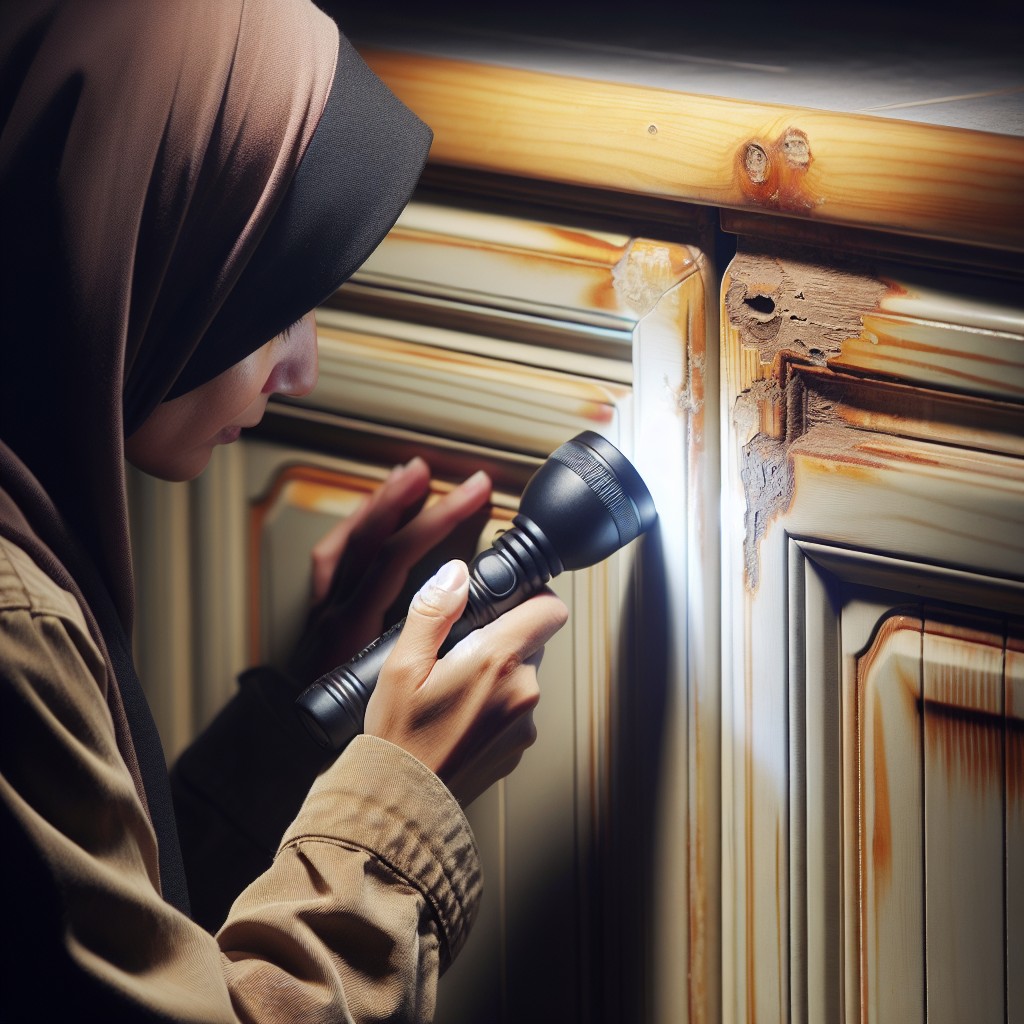Last updated on
The how-to guide will elucidate the step-by-step method to painting kitchen cabinets effectively and affordably, helping to transform your kitchen space with an elegant new look.
Key takeaways:
- Assess cabinet condition: DIY or hire a professional?
- Choose paint type and color carefully.
- Prep workspace: clear area, remove doors and hardware.
- Sand, fill, and prime cabinets before painting.
- Follow detailed painting process and maintain cabinets properly.
What's Inside
Assess the Condition of Your Cabinets and Decide Whether You Can DIY or Need a Professional

Evaluating your cabinets’ condition is like a mini health check-up before diving into a makeover. Look for signs of significant damage, like wood warping or mold. This might signal the need for a professional.
If it’s just a dated color or surface scratches, roll up your sleeves—you’re likely up for a DIY project! Consider your experience with painting and tools. Confident with a brush? Great. If you’ve never held a paintbrush, though, you might want to practice or consult someone with know-how.
Take stock of the cabinet material. Solid wood, wood veneer, and laminate all have different prep and paint requirements. If navigating these nuances feels overwhelming, a professional can ensure you don’t waste effort on the wrong approach.
Lastly, be realistic about time. Can you commit a weekend or more? If a busy schedule threatens to stretch the project over months, hiring might save your sanity and time.
Choose the Right Type of Paint and Color for Kitchen Cabinets
When selecting paint, prioritize options designed for cabinetry; they’re tougher and can handle the frequent cleaning kitchens often require. A semi-gloss or satin finish is ideal, providing a balance between a pleasant sheen and easy maintenance. Oil-based paints have long been the gold standard for their durability, but advancements in water-based acrylic enamel paints now offer similar resilience without the odors and complex cleanup.
Choosing a color that complements your kitchen’s ambiance and the overall design of your home is crucial. Lighter hues can make small spaces appear larger and are timeless, while darker tones add a touch of sophistication but may require additional lighting to maintain a bright kitchen environment. Consider the color of your backsplash, countertops, and appliances – a harmonious palette creates cohesion.
Lastly, always buy a little extra paint than you calculate. It ensures you have enough for touch-ups or any unexpected second layers, keeping color consistency throughout your cabinets without the worry of a shade mismatch from different batches.
Prepare Your Workspace for the Painting Project, Including Removing Cabinet Doors and Hardware
Before diving into the painting process, it’s crucial to create an optimal environment for your endeavor. Here are key steps to prepare your workspace:
1. Clear the Area: Begin by moving any kitchen appliances or furniture that could get in the way. Cover countertops and floors with drop cloths or old newspapers to protect them from paint splatters.
2. Label and Remove Doors: As you take off each cabinet door, number them and their corresponding locations with a small piece of painter’s tape. This ensures a hassle-free reinstallation after painting.
3. Detach Hardware: Using a screwdriver, carefully remove all handles, knobs, and hinges. Keep these pieces together in a bag or container to prevent any loss.
4. Clean Surfaces: Wipe down all cabinet surfaces with a degreaser. Any grease or dirt left on the cabinets can prevent the primer and paint from adhering properly.
5. Set Up a Work Station: Designate a well-ventilated area to lay out all your cabinet doors and drawers for painting. Sawhorses with a plywood base or drop cloths on the ground can serve as an ideal setup.
Taking these preparatory steps seriously lays the foundation for a smoother painting process and ensures professional-looking results for your kitchen transformation.
Understand the Importance of Sanding, Filling, and Priming Cabinets Before Painting
Sanding your cabinets creates a smooth base that ensures the new paint adheres properly. Skipping this step can lead to chipping paint or an uneven finish. It’s not just about giving it a quick once-over—attention to detail will pay off in the long run.
Cracks and holes may seem small, but they can be quite evident once paint is applied. Wood filler is your ally here, ensuring a flawlessly smooth surface. Remember, the filler should be given ample time to dry before any sanding is done.
Priming might seem like an unnecessary extra step, but it’s essential. It acts as an intermediary layer that promotes better paint adhesion and increases the durability of your paint job. Plus, it’s a lifesaver when covering dark or stained wood, as it prevents any bleed-through.
Each step serves as a cornerstone to the one that follows. Adopt a meticulous attitude during prep work and the brushing or spraying that comes afterwards will go smoother. Paint might be the star, but it’s the sanding, filling, and priming that are the unsung heroes of any cabinet transformation.
Detailed Painting Process for Kitchen Cabinets and Post-painting Maintenance Tips
Once your cabinets are primed and ready, it’s time to get painting. Using a high-quality brush or a foam roller ensures a smoother finish, with brush strokes applied in the direction of the grain. For best results, apply paint in thin, even layers, allowing ample drying time between coats. Usually, two coats of paint will suffice, but some colors may require additional layers for an opaque finish.
After the paint has dried, reattach the hardware and doors. Be cautious not to tighten screws too much, as this can damage the fresh paint. Regular cabinet maintenance is straightforward: wipe surfaces with a soft, damp cloth and mild detergent. Avoid harsh chemicals or abrasive cleaners, as these can wear down the paint over time. Touch up any chips or scratches promptly to keep your kitchen cabinets looking their best.




